
I. Introduction
Gross margin is a valuable financial metric that helps business owners assess profitability. It measures the profitability of a company’s products after deducting the cost of goods sold (COGS).
Understanding your gross margin is crucial because it helps you understand your profitability and the prices you need to charge to sustain your business. In this article, we’ll show you how to calculate gross margin with a step-by-step guide, practical examples, and helpful tips.
II. Step-by-Step Guide
Calculating gross margin involves deducting the cost of producing a product from its selling price. To calculate the gross margin, follow the steps below:
- Determine the cost of goods sold (COGS): This includes the cost of raw materials, labor, and any other expenses related to producing the item.
- Calculate the total revenue: This is the total amount of money you received from sales during a specific period.
- Subtract the COGS from the total revenue: Deducting the COGS from the total revenue will give you the gross profit.
- Divide the gross profit by the total revenue: This will give you the gross margin percentage.
Here’s an example:

In this example, the COGS is $20,000, and the total revenue is $50,000. Subtracting the COGS from the total revenue gives you a gross profit of $30,000. Dividing the gross profit by the total revenue gives you a gross margin of 60%.
III. Real-World Example
Let’s take a look at a real-world example. A bakery produces and sells cupcakes. The bakery’s COGS include the cost of ingredients, packaging, and labor. The bakery sells 50,000 cupcakes in one month at a price per unit of $2. The COGS per unit of each cupcake is $1.25
To calculate the bakery’s gross margin:
- The total revenue for the bakery in the given month would be 50,000 x $2 = $100,000.
- The total COGS would be 50,000 x $1.25 = $62,500.
- The gross profit would be $100,000 – $62,500 = $37,500.
- The gross margin percentage for the bakery would be ($37,500 ÷ $100,000) x 100 = 37.5%.
This example demonstrates how businesses can calculate gross margin to determine their profitability and make informed pricing decisions.
IV. Infographic
Infographics are a visual way to represent information. Below is an infographic on how to calculate gross margin, which you can refer to while calculating your gross margin.

V. Case Studies
Now, let’s take a look at some case studies of companies that have improved their margins by applying specific strategies.
- Case Study 1: XYZ company was struggling with low gross margins. One of the strategies they implemented was to reduce the cost of goods sold. They achieved this by sourcing raw materials from overseas and investing in automation technology, which led to significant cost savings.
- Case Study 2: ABC Ltd was facing fierce competition in their industry, and they needed a way to stand out. One of the strategies they adopted was to bundle their products and services, which helped them increase their average order value and customer loyalty. This, in turn, helped them improve their gross margin.
These case studies show that there are different ways to improve gross margin, and it’s essential to identify the right strategies for your business.
VI. Tips and Tricks
Here are some helpful tips and tricks for improving your gross margin:
- Review pricing strategy: One of the quickest ways to improve your gross margin is to review your pricing strategy. Consider raising prices, offer premium pricing options, or segment your pricing based on your target audience.
- Reduce production costs: Review your production processes and identify areas where you can reduce costs, such as negotiating better deals on raw materials or investing in technology that can reduce labor costs.
- Optimize your inventory management: Having too much inventory can tie up your cash and result in deadstock. Optimize your inventory levels to keep them lean and efficient, reducing carrying costs.
VII. Pros and Cons of Different Methods for Calculating Gross Margins
There are different methods of calculating gross margins, and each method has its pros and cons.
- Standard gross margin: This is the most straightforward method of calculating gross margins. It involves subtracting the cost of goods sold from the total revenue.
- Markup gross margin: This method involves adding a percentage to the cost of goods sold to determine the selling price. The pros of this method include simplicity and ease of use. The cons include potential errors in pricing and not factoring in different production costs.
- Variable gross margin: This method involves factoring in different production costs to determine gross margins. The pros of this method include accuracy and a better understanding of product costs. The cons include complexity and may require specialized knowledge to implement.
Understanding the pros and cons of different methods can help businesses determine the best methods for calculating gross margins that suit their needs.
VIII. Common Mistakes
Here are some common mistakes that businesses make when calculating gross margin:
- Not factoring in all costs: It’s essential to consider all costs involved in producing a product, such as labor, packaging, and shipping.
- Misinterpreting gross margin: Gross margin is not the same as a net profit. It only measures the profitability of a product and doesn’t consider other expenses such as rent, salaries, and taxes.
- Using inaccurate data: Using inaccurate data can lead to incorrect calculations and financial decisions. Always ensure that your data is accurate and up-to-date.
Avoiding these common mistakes can help businesses make informed financial decisions and improve their gross margins.
IX. Conclusion
Calculating gross margin is an essential skill for any business owner as it helps in understanding profitability and the prices needed to be charged to sustain the business. Using our step-by-step guide, real-world examples, and helpful tips, you can start calculating your gross margins with ease. By understanding gross margins, applying relevant strategies, and avoiding common mistakes, businesses can improve profitability and achieve success.




